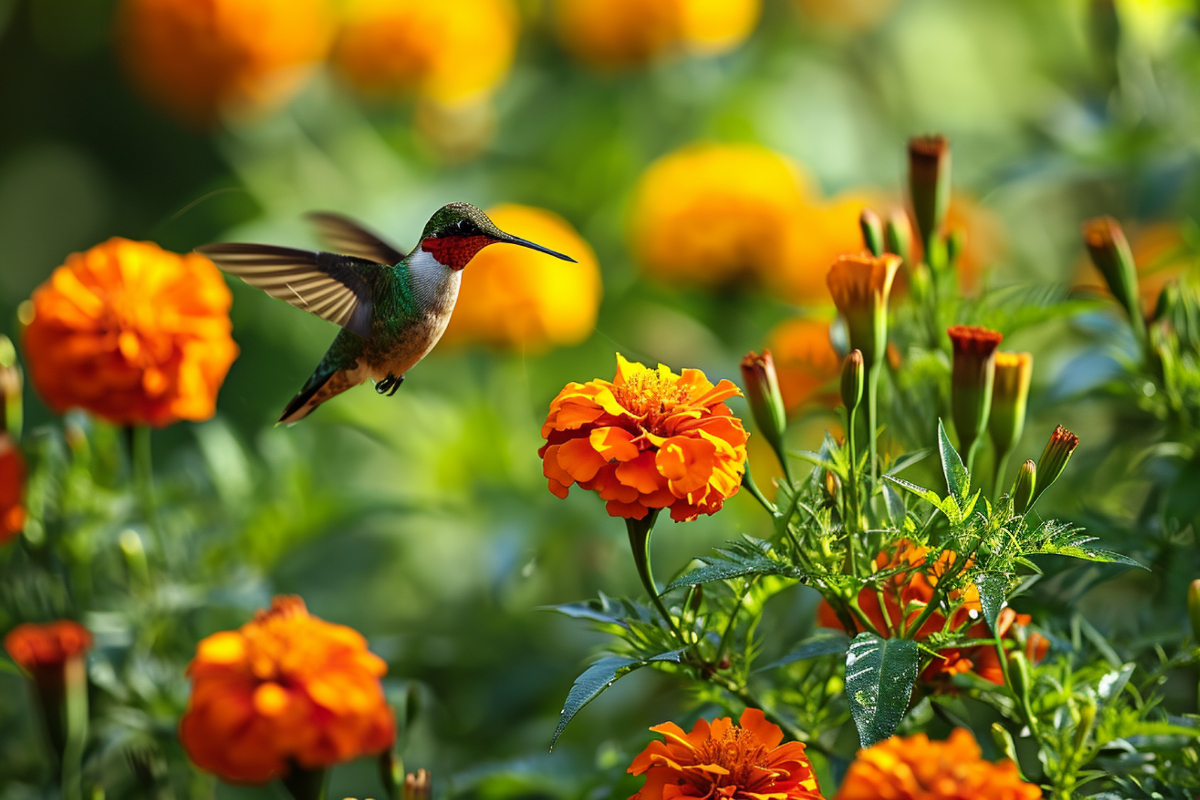Many plants will come to mind when planning a garden to attract hummingbirds, plants such as marigold flowers. However, many wonder, do hummingbirds like marigolds?
With their bright, warm colours and reputation for being easy to grow, marigolds may seem like an obvious choice.
However, the reality is more nuanced when it comes to marigolds’ appeal for hummingbirds.
Do Hummingbirds Really Like Marigold Flowers?
While marigolds don’t top the list of the most attractive flowers to hummingbirds, they can play a complementary role in a garden designed to draw these captivating birds. Marigolds rank lower in nectar production compared to tubular flowers, which hummingbirds prefer.
However, marigolds do offer visual appeal and can attract small insects that hummingbirds eat. So they are worth including alongside more hummingbird-favored blossoms.

Related post to read: Hummingbird Diet and Nutrition.
- Do Hummingbirds Really Like Marigold Flowers?
- Marigolds Nectar Production and Flower Shape
- Colour Preferences
- Small Insect Appeal
- The Verdict – Do Hummingbirds Like Nectar from Marigolds Flower?
- Other Factors in Hummingbird Appeal
- Designing Your Hummingbird Garden
- Why Attract Hummingbirds?
- Conclusion
- Frequently Asked Questions About Hummingbirds and Gardens
- Useful Links:
Marigolds Nectar Production and Flower Shape
A key consideration is that marigolds don’t produce large amounts of nectar compared to flowers that rely on hummingbirds for pollination. Producing nectar requires a lot of plant energy, so flowers evolve to match nectar supply with pollinator demand. Marigolds mainly rely on other insects for pollen transfer.
This can also be seen in their short and compact design. Hummingbirds’ slender tubular bills are perfectly adapted to access nectar from similarly tubed flowers like fuchsias. However, this physical mismatch is why hummingbirds don’t flock to take nectar from marigolds.
Colour Preferences
Now, marigolds are highly commended for their bright, cheery hues, but studies reveal that hummingbirds have a particular fondness for red hues, which have a high reflectance in their visual range.
Hummingbirds are guided to a delightful reward by red blooms such as fuchsia, cardinal flower, trumpet vine, and bee balm, which radiate like beacons. In short, marigolds don’t have the rich red colours that hummingbirds love.
They lack the extra visual attraction catered to a hummingbird’s sense of colour, even though their colours are attractive to us.
Small Insect Appeal
While marigolds may not offer the sweetest or most convenient nectar access, they do provide an indirect benefit – attracting small insects that hummingbirds capture to meet their protein needs.
So, those marigolds still contribute by drawing in supplementary food sources. Hummingbirds regularly supplement their nectar diet with tiny insects and spiders. They precision-hunt bugs attracted to flowers and foliage. So, those busy marigolds still offer habitat value.

The Verdict – Do Hummingbirds Like Nectar from Marigolds Flower?
Given the nectar limitations and physical fit issues, marigolds land pretty low on the list of flowers preferred by hummingbirds. Dedicated hummer flowers like sages, penstemons, fuchsias and others are more reliable bets. But marigolds can serve as colourful secondary support players.
Their insect appeal and general garden presence still add value for attracting hummingbirds to share your garden space. There is no need to rule out marigolds entirely – just don’t depend on them as hummingbird superstars!
Other Factors in Hummingbird Appeal
Beyond nectar production and flower shapes, there are a few other considerations that contribute to a plant’s appeal for hummingbirds in your garden landscape.
Native Plants
Incorporating native flowering plants suited to your climate and geography can give you an advantage in drawing hummingbirds. Native species have co-evolved right alongside hummingbird populations, resulting in specialised adaptations that serve each other’s needs.
They yield more nectar with higher sugar concentrations. Their colours, scents and shapes beckon hummingbirds. Promoting native plants provides essential food and habitat – a win-win for hummingbirds and local ecological balance.
Tubular Flowers
Along with red shades, long, tubular flower shapes perfectly match the hummingbird’s feeding method and slender bill structure. Trumpet-shaped blossoms give easy access to nectar rewards.
Cup or bell-shaped flowers also do well. Just avoid shorter, wider flowers. Go tubular for maximum hummer nectar feeding appeal! Some excellent tubular flowers include sages, penstemons, trumpet honeysuckle and coral honeysuckle.
Plant Placement
Hummingbirds are highly territorial, so they don’t like competing. Even a large garden can only accommodate a few breeding/nesting pairs. Place flowering plants in small clusters rather than solitary plants spread far apart.
Close groupings allow hummingbirds to efficiently guard resources. Sheltered spots, away from prevailing winds and rain, also appeal more. And keep feeders close to flowers for supplemental energy.
Continual Bloom Periods
Hummingbirds need a reliable nectar supply during their entire time residing in your area. Spring and fall migratory periods are especially taxing. Choose a variety of flowering plants that collectively bloom from spring through fall.
Mix early bloomers like honeysuckles with mid-summer stalwarts like bee balms and late contributors like fuchsias. Overlapping bloom sequences keep hummers happy and energised year-round!
Supplemental Feeding
An excellent way to boost hummingbird numbers is by providing supplemental nectar via specialised feeders. Feeders offer backup when blooms are scarce and provide fuel for migrating hummers. Use a basic 1:4 ratio of white granulated sugar dissolved in water.
Boil the mixture for 1 minute, then cool it before filling it with clean feeders. Place feeders in the shade with perches nearby. And be vigilant about keeping feeders clean and nectar fresh.
Related Post To Read: 33 Top Plants That Attract Hummingbirds.
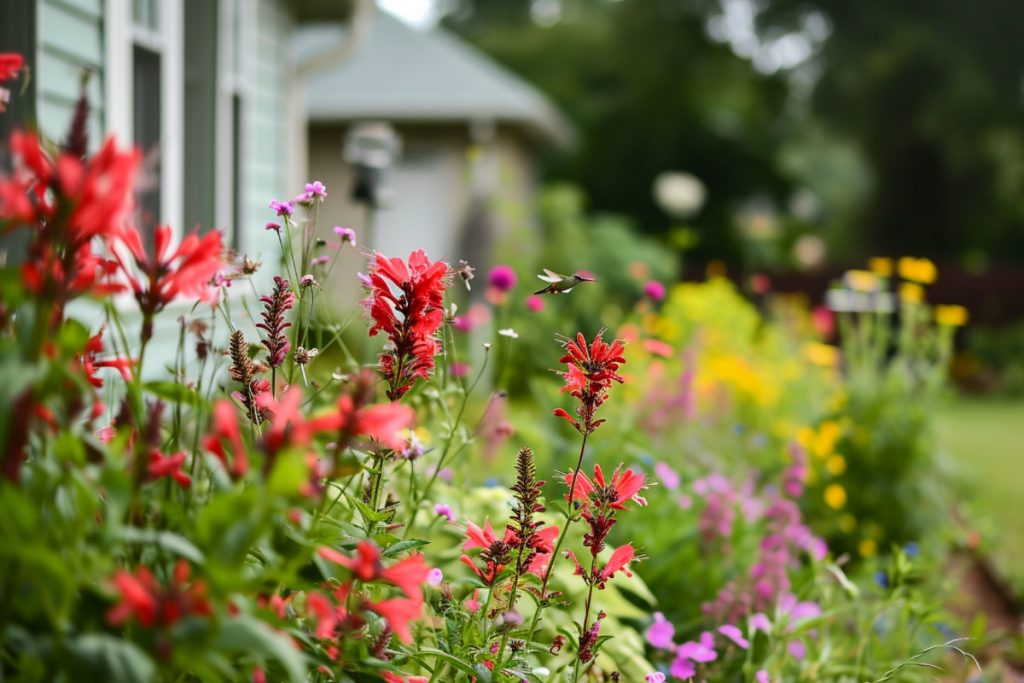

Designing Your Hummingbird Garden
Use the above advice to help you plan and establish a hummingbird-friendly garden that includes a range of flowering plants. Try to find predominantly native red flowers that are specific to your area.
Add more colourful flowers with a lot of nectar, and mix blooming trees, shrubs, and vines with herbaceous plants for a more varied look. Plant in clusters and place them close to extra feeders. Provide shelter from wind, rain and predators. And always avoid pesticides!
Here are some excellent candidates for hummingbird gardens by region:
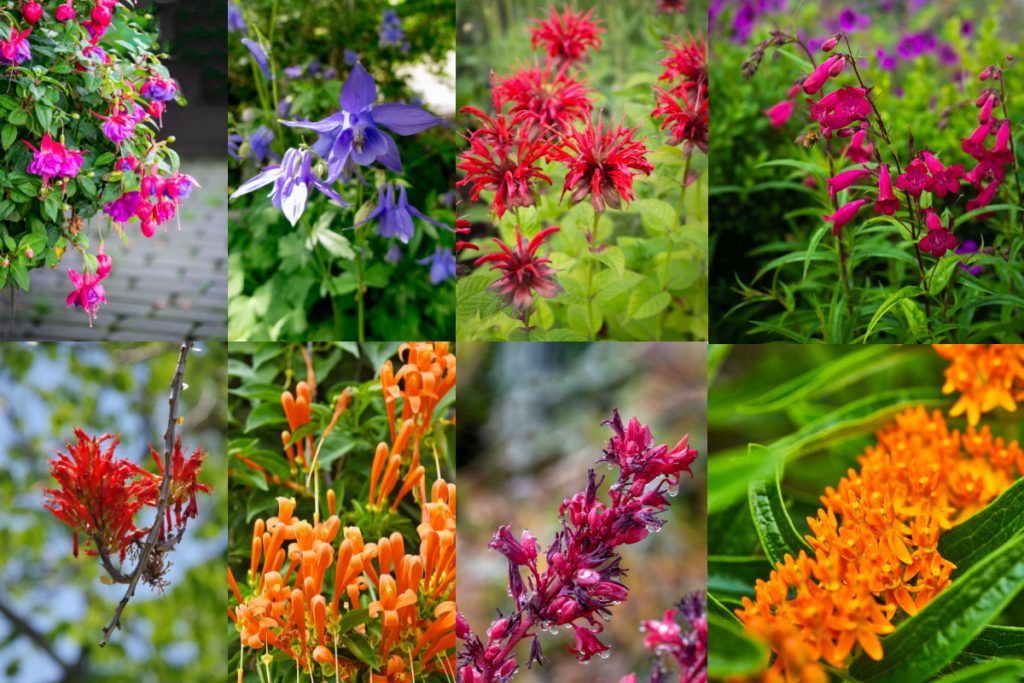
Western U.S.
- Fuchsia
- Penstemon
- Columbine
- Trumpet Honeysuckle
- Coral Honeysuckle
- Cardinal Flower
- Bee Balm
- Pineapple Sage
- Firecracker Plant.
Southwestern U.S.
- Desert Honeysuckle
- Texas Sage
- Apache Plume
- Baja Fairy Duster
- Parry’s Penstemon
- Desert Willow
- Ocotillo
- Red Yucca
- Pineapple Sage.
Eastern U.S.
- Cardinal flower
- Trumpet vine
- Bee balm
- Butterfly weed
- Cross vine
- Fuchsia
- native Azaleas
- Sages
- Columbine.
Southeastern U.S.
- Coral honeysuckle
- Crossvine
- Trumpet vine
- Cardinal flower
- Bee balm
- Pineapple sage
- Firebush
- Pentas
- Porterweed.
Following these guidelines, you can create a lively and welcoming habitat filled with the flash and dazzle of hummingbirds all season long. A bit of planning goes a long way when trying to attract these flying jewels.
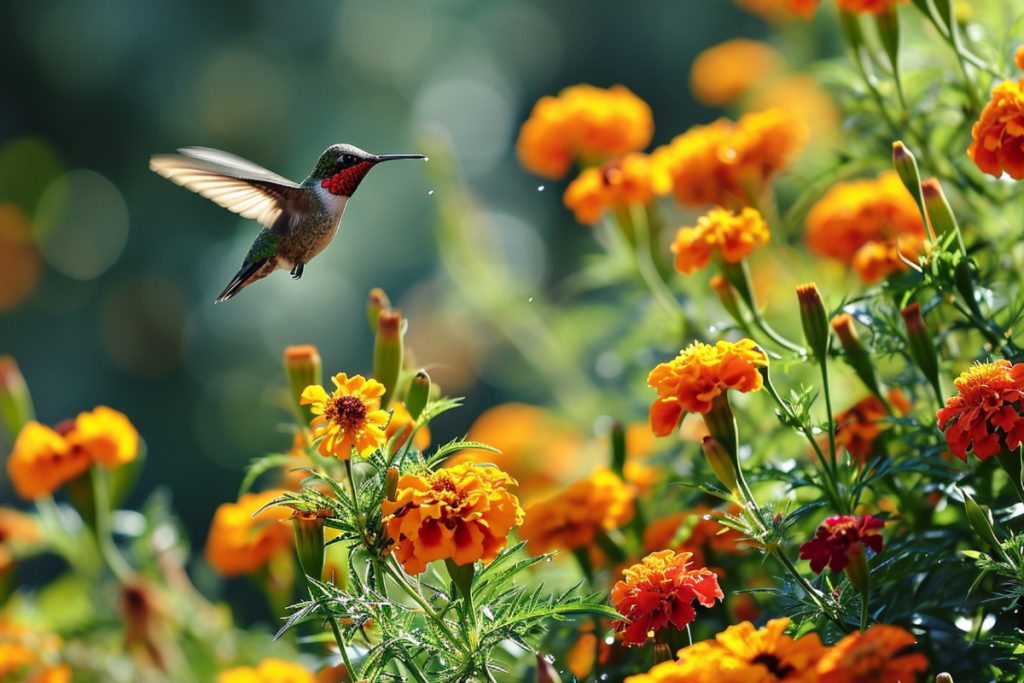
Why Attract Hummingbirds?
With over 300 species of hummingbirds diving, dashing and shimmering their way through the Americas, why make an effort to draw them close? These smallest of birds certainly earn their keep when they visit a garden. Beyond their beauty and fascinating behaviour, hummingbirds provide some tangible benefits.
Pollination Services
Hummingbirds rank as key pollinators for many flowering plants across North and South America. As they access nectar, pollen grains stick to their heads and feathers, riding to the next blossom for crucial cross-pollination. Some species have evolved exclusive reliance on hummingbirds for reproduction. So, by supporting hummingbirds, your garden reaps the rewards of better fruiting and seed production.
Pest Patrol
Hummingbirds supplement their sugary nectar diet with protein from tree sap, pollen and small insects. A hummingbird may consume hundreds of tiny insects every day. They aggressively pick bugs off leaves and flowers with their darting sorties. Fewer plant pests mean less damage to blossoms and foliage in your garden landscape.
Seed Dispersal
Hummingbirds take on another helper role as they ingest and then excrete seeds of native plants. Their far-ranging travels distribute key native plant species. In fact, some plants completely rely on hummingbirds to disperse seeds from their fleshy fruits. Supporting hummingbirds ultimately aids broader ecosystem regeneration.
Joy and Inspiration
Lastly, the sheer delight hummingbirds provide is reason itself to welcome them. Their energetic antics and graceful manoeuvres never fail to brighten a day. These tiny dynamos remind us that beauty and wonder can come in small packages. Their persistence and pugnacity illustrate how life perseveres despite fragility.
And for many cultures of the Americas, hummingbirds symbolise hope, joy, energy and renewal. These uplifting attributes may be the most compelling reason of all to open your garden gates to hummingbirds!
Conclusion
In conclusion, you benefit the ecosystem greatly when you designate a hummingbird-friendly spot in your garden. Your garden will join a more extensive network facilitating hummingbirds’ long-distance migration.
Hopefully, with the help of the tips discussed in this article, you will be able to create a garden that hummingbirds like visiting.
Please feel free to let me know if you have any other questions regarding this topic.
In the meantime, I wish you much joy watching these incredible birds zoom and dance around your garden!

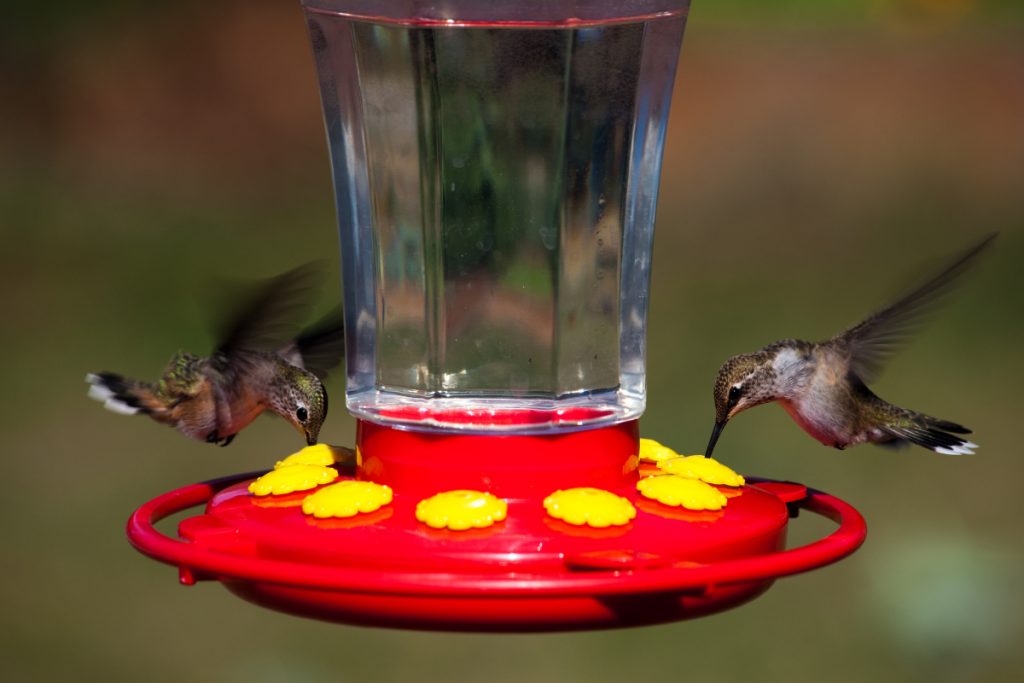
Frequently Asked Questions About Hummingbirds and Gardens
Here are answers to some common questions about what hummingbirds need and how best to support them in home gardens.
Q: What is the best way to attract hummingbirds?
A: Providing a diverse array of tubular red flowers tailored to your climate is the surest way to catch hummingbirds’ attention. Supplement with other bright, nectar-rich blooms. Include flowering trees, shrubs and vines at multiple heights. Plant in groups, away from wind and rain. Add nectar feeders for extra appeal. Avoid pesticides!
Q: Do hummingbirds drink water?
A: Hummingbirds get needed water from flower nectar and plant sap. But they will use water features like drippers, misters and small fountains, especially in hot, arid climates. Position water sources near flowers and perches.
Q: What is the best hummingbird feeder?
A: Choose a simple, easy-to-clean feeder with red accents. Have ample perch space and bee guards on nectar ports. Position in light shade with good visibility overlooking your garden. Keep nectar fresh by changing every 2-3 days, more often in hot weather.
Q: How close should hummingbird feeders be to flowers?
A: Locate feeders within fluttering distance – 5-10 feet from natural flowers, vines or nectar plants. This allows hummingbirds to efficiently supplement as needed between flower visits.
Q: What plants attract the most hummingbirds?
A: The most reliable hummingbird plants offer tubular red flowers with an abundance of nectar. Top choices are bee balm, cardinal flower, trumpet vine, native honeysuckles, penstemon, fuchsia, pineapple sage and firecracker plant. Plant these hummingbird favourites in groups for the best attraction.
Useful Links:
Related Posts to Read:
- Do Hummingbirds Beaks Open When Feeding?
- The Mysteries of Hummingbird Flight.
- 6 Fascinating Facts About Hummingbird Sizes.
- Ruby-Throated Hummingbird Migration Map.
- Where Do Hummingbirds Go When It Rains?
- How Much Does A Hummingbird Eat Per Day?
References:
- About Hummingbird (Link).
- Greenewalt, C. H. (1960). Hummingbirds. New York: Doubleday. Google Scholar.
- Carey C. The impacts of climate change on the annual cycles of birds. Philos Trans R Soc Lond B Biol Sci. 2009 Nov 27; 364(1534):3321-30. doi: 10.1098/rstb.2009.0182. PMID: 19833644; PMCID: PMC2781852.
- Rico-Guevara A, Rubega MA, Hurme KJ, Dudley R. Shifting Paradigms in the Mechanics of Nectar Extraction and Hummingbird Bill Morphology. Integr Org Biol. 2019 Jan 2;1(1):oby006. doi: 10.1093/iob/oby006. PMID: 33791513; PMCID: PMC7671138.
- Tyrrell LP, Goller B, Moore BA, Altshuler DL, Fernández-Juricic E. The Orientation of Visual Space from the Perspective of Hummingbirds. Front Neurosci. 2018 Jan 30;12:16. doi: 10.3389/fnins.2018.00016. PMID: 29440985; PMCID: PMC5797624.
- Hummingbirds Sighting (Journey North Map).
- About Hummingbird’s Characteristics.
